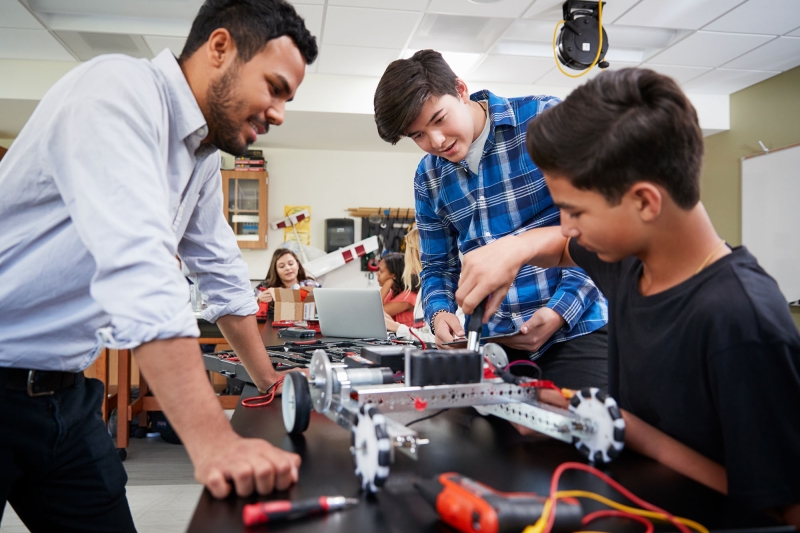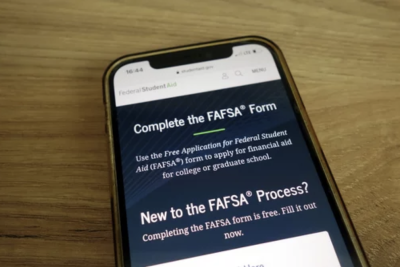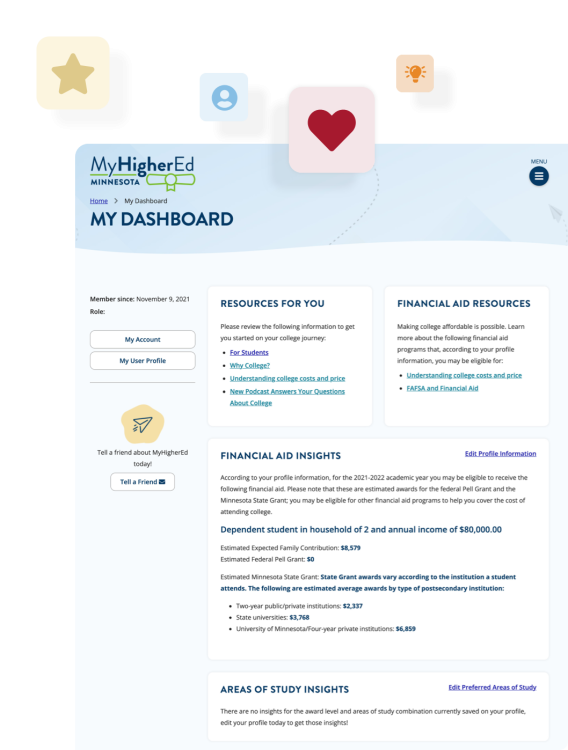Grants are a large source of financial aid, one that doesn't need to be repaid. Often considered need-based aid, grants are like gifts that are awarded to students with the fewest financial resources. This need is determined when you fill out the Free Application for Federal Student Aid (FAFSA). The funds usually come from federal and state government and are sent directly to the postsecondary institution on the students’ behalf.
Are You Eligible To Receive a Grant?
Even though most grants are meant for low-income students, most students are eligible to receive some state financial aid; evidently, the amount of the award will vary according to their financial need. For this reason, we encourage every student to fill out the FAFSA as a first step.
Please, read carefully each of the following grants and their eligibility:
Federal Pell Grant
For 2021-2022, Pell Grants range from $650-$6,495 per academic year. Students with family incomes up to $65,000 may be eligible for a federal Pell Grant, although most awards go to students with lower family incomes.
You may receive a Pell Grant for your undergraduate study until you complete a bachelor’s degree, or receive a grant for the equivalent of 12 full-time semesters, whichever comes first. You may use it at almost any college. In some cases, you may receive a Pell Grant for attending a post-graduate teacher certification program.
Pell Grant Eligibility
- Be enrolled in a program leading to a certificate, degree or diploma at a college eligible to participate in the Federal Pell Grant program.
- Have a high school diploma, including home school or GED. (Some exceptions apply).
- Maintain satisfactory academic progress. If you are receiving federal student aid, you must maintain a “C” average and stay within your institution’s graduation standards. You must be completing enough courses each term to graduate in a timely manner.
- Sign a statement that you do not owe a refund on a Pell Grant, are not in default on a federal loan, and that you agree to use your student aid only for educational purposes.
- Not be convicted for the possession or sale of illegal drugs while receiving federal financial aid.
- Be a United States citizen or eligible non-citizen.
- You are an eligible non-citizen if you:
- Have a Permanent Resident Card (I-551).
- Are a conditional permanent resident with an 1-551C Card.
- Have an Arrival Departure Record (I-94) from the Department of Homeland Security with any of the following designations: refugee, asylum granted, parolee, victim of human trafficking, T-Visa holder, or Cuban-Haitian entrant.
By completing your FAFSA, you will automatically be reviewed for Pell Grant eligibility. There is not a separate application needed to be considered for this grant.
Minnesota State Grant
The Minnesota State Grant Program is a state-funded need-based program and is available for students who have not yet attended eight full-time semesters of postsecondary education or the equivalent. To receive a State Grant for a term, the FAFSA must be submitted to the federal processing center by June 30th of the school year in question. For example, for school year 2023-2024, the deadline is June 30th, 2024 and for school year 2024-2025, the deadline is June 30th, 2025. The average award for a full-time student for one year is about $3,168 (fiscal year 2023).
The program works in coordination with the Federal Pell Grant Program. It’s available to Minnesota residents who enroll for at least three credits as undergraduate students in programs leading to certificates, degrees or diplomas at a participating school within the state. Students are responsible to pay at least 50 percent of their cost of attendance from savings, earnings, loans, or other financial aid from the college or a private source.
MN State Grant Eligibility
Minnesota residents who:
- Are graduates of a secondary school or its equivalent or are at least 17 years of age.
- Will be enrolled as undergraduates for at least three credits at one of more than 130 eligible schools in Minnesota.
- Have not yet attended eight full-time semesters of postsecondary education or the equivalent. Students who have withdrawn for active military service or for a major medical illness while under the care of a physician after December 31, 2002 are given an extra term of eligibility.
- Have NOT received a baccalaureate degree.
Other considerations
- Students who are in default on a student loan or who are more than 30 days behind on child support owed to a public agency are NOT eligible, unless they have established payment plans with the appropriate agency and made a series of on-time monthly payments. Click here for more information on reestablishing eligibility for financial aid after a federal student loan default.
- Students may receive State grants for four consecutive full-time quarters or three consecutive semesters during the course of a single fiscal year.
- Students must reapply each year to be considered for a grant. A State grant can be renewed for up to six full-time semesters or nine quarters (or their equivalent). However, the student must make satisfactory progress and demonstrate financial need as defined in state law.
Public Safety Officers’ Survivor Grant Eligibility
To qualify for this award, you must be a dependent or spouse of a public safety officer killed in the line of duty on or after January 1, 1973. Dependents must meet the following requirements:
- Less than 23 years old or less than 30 years old if served on active military duty for 181 consecutive days or more, and was honorably discharged or released; and
- Enroll in an undergraduate or certificate program at one of the postsecondary institutions in Minnesota that participate in the State Grant program Surviving spouses of all ages and dependents under age 23 are also eligible to use awards for graduate study.
Applicants need to take a certificate of eligibility to the financial aid office of the school they attend or plan to attend. This certificate can be obtained from:
Commissioner’s Office - Minnesota Department of Public Safety
Telephone: (651)201-7160
Minnesota Postsecondary Child Care Grant
Students who have children 12 and under (14 and under if disabled) and demonstrate financial need may receive assistance under the Minnesota Postsecondary Child Grant Program (MPCG) to help pay for child care.
The financial assistance may cover up to 40 hours per week per eligible child. The amount of the grant award is based on the income of the applicant and spouse, number in the applicant’s family, number of eligible children needing child care, the actual cost of child care, and whether the student is enrolled full or part time. Grants are available for both undergraduate and graduate students.
Child Care Grant Eligibility
You are eligible to apply for a Postsecondary Child Care grant if you:
- Are a resident of Minnesota, including spouses of Minnesota residents and undocumented students who qualify under the MN Dream Act.
- Have a child 12 years of age or younger (14 years of age or younger if disabled), who is receiving or will receive care on a regular basis from a licensed or legal non-licensed care giver
- Meet the program’s income guidelines.
- Are enrolled at least half time (six or more credits for undergraduates; 1 or more credits for graduate students) in an eligible institution.
- Undergraduates have not earned a bachelor’s degree or been enrolled for the equivalent of eight full-time semesters or 12 full-time quarters (an additional term of eligibility is available for students who have withdrawn from school for active military service after January 1, 2013 or for a major medical illness). Graduate and Professional students have an additional 4 years of eligibility after receiving a bachelor’s degree.
- Are pursuing a nonsectarian program or course of study that applies to an undergraduate degree, diploma or certificate.
- Are in good academic standing and making satisfactory progress toward a degree, diploma, or certificate.
- Are not receiving tuition reciprocity.
- Are not in default on any educational loan or, if in default, have made satisfactory arrangements to repay the loan with the holder of the note.
- Are not receiving Minnesota Family Investment Program or Diversionary Work Program benefits during the same term you receive a Postsecondary Child Care grant.
- (A student who receives an award and then receives benefits from the MFIP program during the same quarter must inform the school within 10 days).
You must apply for the Postsecondary Child Care grant through the financial aid office at your school.
Minnesota Future Together Grants
The Minnesota Future Together Grants (FTG) was created to increase the state's workforce in high-need career areas, such as health care, business, STEM, industry and technology, education, and public service. The program offers tuition-free pathways for eligible students by covering the remaining financial need after other aid has been applied -typically, Pell and Minnesota State grants.
Here are a few things to know:
- The Minnesota Future Together Grants are made possible through an investment by Governor Tim Walz with the federal American Recovery Plan funds.
- Grants will be awarded as long as funds are available, with the program expected to end in 2024.
- Eligible programs will vary by campus. Contact your campus to see if your program is eligible.
FTG Eligibility
Students must be enrolled in a certificate, two-year, or four-year program at any Tribal College or public institution in Minnesota, including the University of Minnesota, for the following eligible career areas:
- Healthcare: High need programs include nursing, medical assisting, surgical technicians, healthcare social workers, EMTS, paramedics, and substance abuse and mental health counselors.
- STEM: High need programs include software development, software analysts, industrial engineers, web developers, mechanical engineers, and statisticians.
- Business: High need programs include accounting, financial management, auditors, and project managers.
- Industry and Technology: High need programs include machine tool technologists, operations managers, HVAC technicians, front line supervisors, plumbers, construction managers, electricians/electrical line workers, and heavy-duty mechanics.
- Education: High need programs include teachers, principals, early childhood educators, childcare workers, school counselors and social workers.
- Public service: High need programs include law enforcement officers, probation officers, and firefighters.
Additional eligibility requirements:
- Students must meet the standard eligibility requirements for state financial aid programs;
- Have a Family Adjusted Gross Income (AGI) reported on FAFSA or State Aid Application of less than $100,000 and have worked in a critical industry listed in Executive Order 20-74 at least part-time between March 1, 2020 - December 31, 2021; or received unemployment benefits between March 1, 2020 - December 31, 2021; OR
- Have a Family AGI reported on FAFSA or State Aid Application of less than $50,000.
Student eligibility for the grant will be determined every semester. You will need to fill out the FAFSA or the Minnesota Dream Act application each year. A student who receives a grant one semester is not guaranteed to receive funding for the next semester. Eligibility is subject to the availability of funds and any changes in your enrollment, FAFSA, or other financial aid may change the amount you receive each semester.
If you receive a Minnesota Future Together Grant, your college will contact you. They may also follow up with additional questions to determine your eligibility.
For more information, please reach out to your college. Find contact information for Minnesota higher education institutions here.
College Search Tool
Get in touch with the Financial Aid Office at the college of your choice using the College Search Tool.
Need Help?

Fostering Independence Higher Education Grants
The Fostering Independence Higher Education Grants (Foster Grants) seeks to eliminate the cost barrier to access college for Minnesota students who were in the foster care system.
If you are a Minnesota resident under age 27 and were in the Minnesota foster care system at any point after you thirteenth birthday, this grant may cover the cost of attendance at any eligible Minnesota public or participating private college and university. This includes tuition and fees, supplies, rent/room and board, childcare, and transportation. If you are eligible to receive the grant, your postsecondary institution will award the grant as part of your financial aid package.
Eligible institutions include the state universities, the University of Minnesota, public community and technical colleges, participating tribal colleges and private institutions. Foster Grants may not be used at out-of-state schools.
Foster Grants Eligibility
- You are a Minnesota resident, including students who apply for state financial aid via the MN Dream Act Application
- You are younger than 27 years of age
- You are attending a Minnesota public or participating private higher education institution
- You are eligible for the Education Vouchers for Former Youth in Foster Care OR after your 13th birthday have been in in foster care in Minnesota, including any of the following:
- Placement in foster care at any time while 13 years of age or older;
- Adoption from foster care at any time after reaching 13 years of age; or
- Placement from foster care with a permanent legal custodian at any time after reaching 13 years of age
- You have graduated from high school or completed the equivalent as approved by the Department of Education
- You have been accepted for admission to, or are currently attending, an eligible institution
- You have submitted a FAFSA or Minnesota Dream Act application
- You are meeting Satisfactory Academic Progress as defined by your institution
Foster Grants Application
To apply for the grant, complete the Free Application for Federal Student Aid (FAFSA) form OR the Minnesota Dream Act application. Completing the applicable form will serve as the application for receiving a Foster Grant, as well as other grants and financial aid resources.
If you receive a Foster Grant, each year you will need to reapply via the FAFSA or Minnesota Dream Act to be considered for the grant.
Foster Grants Awards
Once you have completed your FAFSA or Minnesota Dream Act application, the Minnesota Department of Human Services will confirm your foster youth status. The first choice school you list on your application will be notified of your eligibility for the Foster Grant and will complete a school certification. If you are eligible for a Foster Grant, the award will be included on your financial aid award notice from your postsecondary institution.
How Much Money Does the Grant Provide?
The Fostering Independence Higher Education Grant is intended as a 'last dollar' financial aid program.
If you attend a Minnesota public institution, the award will be determined after subtracting the following from your cost of attendance:
- Your Expected Family Contribution (as determined by the FAFSA or MN Dream Act Application)
- All federal and state gift aid (grants and scholarships)
- All tribal scholarships
- The Education and Training Voucher (ETV)
- Extended foster care benefits
- All private grants or scholarships
- All institutional grants, scholarships and tuition waiver or remission amounts
If you attend a participating Minnesota private institution, the recognized cost of attendance will the lesser of the federal Title IV cost of attendance at the institution or the highest federal Title IV cost of attendance for a public two-year institution or public four-year institution in Minnesota. The cost of attendance used for federal Title IV financial aid includes tuition and fees, an allowance for books, supplies, transportation, miscellaneous expenses, and room and board.
For the 2022-2023 academic year, Minnesota’s highest public four-year cost of attendance is estimated to be $34,016. The highest public two-year cost of attendance is estimated to be $24,942. At participating private institutions, the award will be determined after subtracting the following from the recognized cost of attendance:
- Your Expected Family Contribution (as determined by the FAFSA or MN Dream Act Application)
- All federal and state gift aid (grants and scholarships)
- All tribal scholarships
- The Education and Training Voucher (ETV)
- Extended foster care benefits
- All private grants or scholarships not provided by the private institution you are attending
Participating private institutions have agreed to provide institutional grants, scholarships, tuition waivers or remission to cover the gap between what is not covered from the list above and the school's federal Title IV cost of attendance.
For How Long Can You Receive the Grant?
An eligible undergraduate student may receive a Foster Grant in any year of study unless: the student has earned a baccalaureate degree, has attended the equivalent of eight full-time semesters, or received a Foster Grant for five years. Additionally, students enrolled in a two-year degree, certificate or diploma programs are limited to three annual awards or the equivalent. Students enrolled in a four-year undergraduate degree program are limited to five annual awards or the equivalent.
Minnesota Student Teacher Grants
The Minnesota Student Teacher Grants provides financial assistance to eligible postsecondary students enrolled in Minnesota teacher preparation programs during one term in which the student is completing a required 12-week or more student teaching experience. There are two grants available based on eligibility:
- The Minnesota Student Teachers in Shortage Areas Grant (formerly Teacher Candidate Grant) helps eligible students who intend to teach in a license shortage area or rural school district after graduating and receiving their teaching license.
- The Minnesota Underrepresented Student Teacher Grant helps eligible students who belong to a racial or ethnic group underrepresented in the Minnesota teacher workforce.
Depending on the availability of funds, selected undergraduate and graduate students may receive awards of up to $7,500 for one term.
Student Teacher Grants Eligibility
- Be enrolled in an eligible Minnesota college or university in an eligible teacher preparation program that requires at least 12 weeks of student teaching in order for the teacher candidate to be recommended for a full professional teaching license;
- Intend to teach in an identified license field or geographical shortage area or belong to a racial or ethnic group underrepresented in the Minnesota teacher workforce; and
- Complete a Free Application for Federal Student Aid (FAFSA) or Minnesota Dream Act application for the aid year; and Demonstrate financial need.
- Meet one or more of the following requirements:
1. Intend to teach in a designated rural school district in Minnesota
2. Intend to teach in an identified license shortage area
3. Belong to a racial or ethnic group underrepresented in the Minnesota teacher workforce.
"License shortage area” means a licensure area that is identified by the Professional Educator Licensing and Standards Board in coordination with the commissioner using data collected for the teacher supply and demand report under MN Statute 122A.091, subdivision 5. Only licensure areas within the following fields may be identified as a license shortage area:
- English as a second language
- Early childhood
- Special education
- Career and technical education
- Science, technology, engineering, arts, and math
- World languages
The eligible teacher preparation program/licensure areas considered to be designated teacher shortage areas are available here. The rural school districts in Minnesota for the Student Teachers in Shortage Areas Grant is available here.
Eligible Colleges and Universities
- Augsburg University
- Bemidji State University
- Bethany Lutheran College
- Bethel University
- Carleton College
- College of St. Benedict
- College of St. Scholastica
- Concordia College, Moorhead
- Concordia University, St. Paul
- Crown College
- Gustavus Adolphus College
- Hamline University
- Martin Luther College
- Metropolitan State University
- Minnesota State University, Mankato
- Minnesota State University, Moorhead
- North Central University
- Southwest Minnesota State University
- St. Catherine University
- St. Cloud State University
- St. John's University
- St. Mary's University of Minnesota
- St. Olaf College
- University of Minnesota, Crookston
- University of Minnesota, Duluth
- University of Minnesota, Morris
- University of Minnesota, Twin Cities
- University of Northwestern, St. Paul
- University of St. Thomas
- Walden University
- Winona State University
The full list of eligible programs at each College and University are available here.
Student Teacher Grants Application
A student must submit a complete application to the Minnesota Office of Higher Education for the term in which the student is completing a required 12-week or more student teaching experience.
Incomplete applications will not be processed.
- Student Section including all the required information that is signed and dated;
- Completed Free Application for Federal Student Aid (FAFSA) or the Minnesota Dream Act application; and
- College or University Section completed by an authorized representative at the college or university you attend that includes all of the required information.
Click here to apply online or contact our office if you need a paper application. After you apply, please remember to communicate with your school’s Financial Aid Office to submit the College or University Section of the application.
Selection Process
Eligible students submitting a complete application by the priority dates below will be considered for awards in the specified term. If there are insufficient funds to provide an award to all eligible applicants, the applications will be prioritize based on:
- The financial need of an applicant;
- Student Teachers in Shortage Areas Grant: Whether the applicant intends to teach in both a rural school district and a license shortage area
- Underrepresented Student Teacher Grant: The statewide distribution of funds
Priority Deadlines:
Fall 2021: July 31st, 2021
Spring/Summer 2022: November 12th, 2021
Applications will still be accepted after these dates but students are much less likely to be awarded.
Federal Grants for Students in Teacher Preparation Programs
The federal government offers the Teacher Education Assistance for College and Higher Education (TEACH) Grant, which provides grants of up to $4,000 per year to students who intend to teach in an elementary or secondary school that serves students from low-income families. In exchange for receiving a TEACH Grant, students must agree to serve as a full-time teacher in a public or private school serving low income students for at least four academic years within eight calendar years of completing the program of study for which they received a TEACH Grant. An important detail: If a student doesn't complete their service obligation, the TEACH Grant will be converted to a Federal Direct Unsubsidized Stafford Loan that they must repay with interest.
If you are interested in becoming an early childhood educator, the T.E.A.C.H. Early Childhood® MINNESOTA offers pathways to earning a postsecondary credential through their scholarship program. T.E.A.C.H. Scholarships can cover up to 85% of the cost of tuition and books for 18 credits per year to help teachers continue their education, increase their wages, and solidify their professional commitment. Visit Child Care Aware to learn about eligibility and application process.
Alliss Opportunity Grant Program for Adults Returning to College
Grants are available to students who are attending a two-year college with financial need. They must be attending Minnesota State Colleges, enrolled in Associate of Arts (A.A.), Associate of Science (A.S.) and Associate of Applied Science (A.A.S.), Associate of Fine Arts (A.F.A.), diplomas, certificates, and Minnesota Transfer Curriculum (MnTC) courses designed to transfer to baccalaureate programs.
Alliss Opportunity Grant Eligibility
- Recipients cannot have already received a baccalaureate degree.
- Recipients do not have to be Minnesota residents.
- Grants will be processed and awarded through the college’s normal financial aid application process and may be used to meet remaining need after the student has received Pell and/or Minnesota State grants.
- Recipients will be required to meet with an advisor to create a baccalaureate degree-completion plan. This meeting must occur during the semester for which the award is granted.
The procedure for selecting recipients of the Alliss Opportunity Grant varies from campus to campus. Please contact the financial aid office at the college you attend (or plan to attend) for more information.
Assistance for Dislocated Workers
The Dislocated Worker Programs serve individuals dislocated from long-held jobs. These programs focus on upgrading current job skills, retraining, and providing support services. Inquire about Dislocated Worker Programs at CareerForce locations or call 651-259-7537 for more information.
Students Who Are Deaf or Blind
Minnesota residents admitted to the University of Minnesota who are blind may be eligible for a tuition waiver from the university. Minnesota residents who are deaf and who qualify for either a Pell or State Grant may be eligible for tuition and fee assistance at the public college or university to which they have been admitted. Contact the college’s financial aid office to learn more.
Grants for Students with Intellectual and Developmental Disabilities (ID Grant)
This program provides students with intellectual and developmental disabilities with financial assistance for tuition and fees (funds may vary each year) at eligible and participating institutions.
ID Grant Eligibility
To qualify for this program, a student must:
- Be enrolled in and attending an eligible comprehensive transition program.
- Have tuition and fees not covered by the Federal Pell Grant, State Grant, or institutional aid.
- Be a Minnesota resident.
- File a current Free Application for Federal Student Aid (FASA) or MN Dream Act
Participating Minnesota Institutions:
ID Grant Application
Get in touch directly with the program at any of the participating institutions:
- Bethel University BUILD Program | Phone: 651.635.8799 | Email: build-program@bethel.edu
- Central Lakes College Occupational Skills Program | Phone: 218.855.8075 | Email: psloan@clcmn.edu
- Ridgewater College Occupational Skills Program | Phone: 320.222.8040 | Email: jay.morrison@ridgewater.edu
The Federal Supplemental Educational Opportunity Grant (SEOG)
The Federal Supplemental Educational Opportunity Grant Program makes awards to exceptionally needy students and can add $100 to $4,000 in grant money to the financial aid package. The award amount is set by the institution’s financial aid office and depends on the availability of funds at your school and the amount of other aid you are receiving. The financial aid office at your school will use your FAFSA results to determine the size of your award.
SEOG Eligibility
Only undergraduate students are eligible, and priority is given to students already receiving a Pell Grant. Students must be United States citizens or eligible non-citizens.





